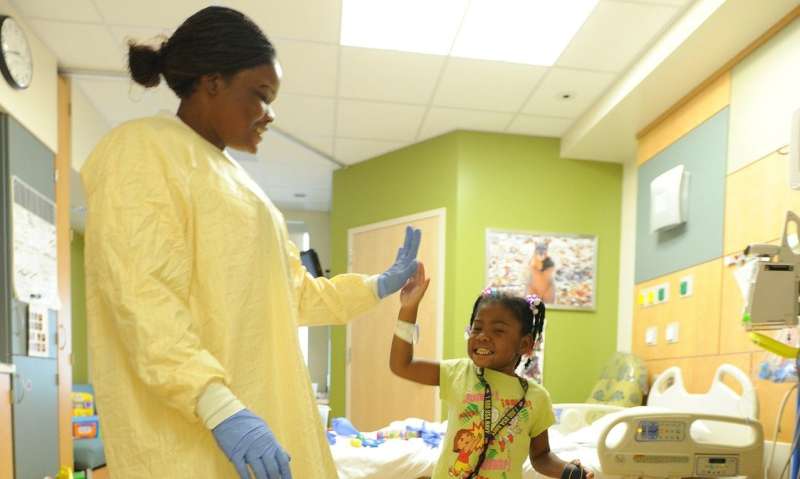Early combined treatment with biologic and conventional DMARDs could be effective for polyarticular juvenile arthritis

New research presented this week at ACR Convergence, the American College of Rheumatology's annual meeting, found that patients started on early, aggressive treatment with a combination of biologic and conventional disease modifying antirheumatic drugs (DMARDs) achieved clinically inactive disease in children with polyarticular juvenile idiopathic arthritis (JIA) more frequently compared to other treatment plans 24 months after starting treatment.
Polyarticular JIA affects five or more joints and can begin at any age. The overall treatment goal for polyarticular JIA is to control symptoms, prevent joint damage, and maintain function. Some children may achieve clinical inactive disease with treatment.
The study compared three consensus treatment plans, or CTPs, for polyarticular JIA that were originally developed by the Childhood Arthritis and Rheumatology Research Alliance (CARRA) to see which one was most effective at achieving clinically inactive disease in previously untreated patients. These researchers previously reported the primary outcomes after 121 months, and now, they are reporting outcomes for patients after 24 months of follow-up.
"The goal of our trial was to compare the three CARRA consensus treatment plans to determine whether the timing of when biologics were started is important in the overall outcomes in untreated polyarticular JIA, using a non-randomized observational study design," says Yukiko Kimura, MD, Chief, Division of Pediatric Rheumatology, at Hackensack University Medical Center in New Jersey, and the study's co-author. "It's crucial to look at longer term outcomes because these allow us to learn about how initial treatment might affect damage and chronic disability, which only occur over years. We can also learn about continuing disease control, quality of life and whether remission on and off medications might be possible."
Three standardized CTPs were compared in the study, which originally enrolled 400 patients:
- Step Up: Starting a conventional synthetic DMARD then adding a biologic if needed after three or more months
- Early Combination: Starting patients on a conventional synthetic and biologic DMARD together
- Biologic First: Starting a biologic DMARD alone and adding a conventional synthetic DMARD after three or more months if needed
Patients were not randomized. Researchers collected data every three months for the first 12 months, then every six months using the CARRA Registry. Although the primary study ended at 12 months, the Registry continues to follow every patient for at least 10 years, allowing longer-term outcomes to be analyzed. The primary outcome measured was the proportion of children achieving clinical inactive disease off glucocorticoids at 24 months. Secondary outcomes werethe clinical Juvenile Arthritis Disease Activity Score based on 10 joints, the Pediatric ACR 70 disease activity score, and patient-reported outcomes.
There were 291 patients who completed their 24-month clinic visit: 188 on Step Up, 76 on Early Combination and 27 on Biologic First. There were some significant baseline differences between the groups, including the number of actively inflamed joints and disease activity scores. At 24 months, 52% of patients on Early Combination achieved clinical inactive disease, compared with 42% of patients on Step Up and 44% on Biologic First. There was a significant difference in clinical inactive disease outcomes that favored Early Combination CTPs over Step Up at 24 months of treatment, but there were no significant differences between the three plans for other study outcomes.
Researchers found that all 3 groups continued to improve at 24 months compared to their outcomes at 12 months, including the clinical Juvenile Arthritis Disease Activity Score and the Pediatric ACR 70 disease activity score. Patients in all 3 groups also showed improvement in pain interference and joint mobility measures from baseline. There were 17 adverse events reported in the study, most commonly infections.
"It's encouraging that in general, most polyarticular JIA patients are doing well at 24 months when treated initially with effective medications. These results suggest that early treatment with biologics in combination with conventional DMARDs may be the most effective strategy in the long term for many patients," says Dr. Kimura. "We will continue to study this patient cohort over longer periods of time and perform other analyses on this data to better understand CTP effectiveness. Polyarticular JIA is still a challenging disease that continues to need better treatment options and a more personalized approach to optimize outcomes."
More information: Yukiko Kimura et al, The Childhood Arthritis and Rheumatology Research Alliance Start Time Optimization of Biologic Therapy in Polyarticular JIA (STOP-JIA) Study: 24-Month Outcomes [abstract]. Arthritis Rheumatology (2021). Available at acrabstracts.org/abstract/the- … y-24-month-outcomes/

















